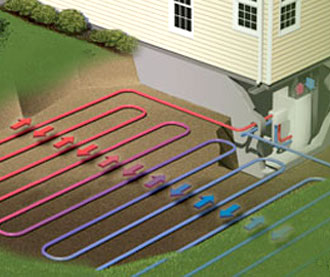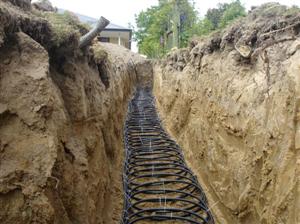Whether you’re buying a new home or looking to improve upon the efficiency of your existing heating and cooling system, a geothermal heat pump installation can help reduce your energy costs.
Both businesses and home owners can vastly benefit from integrating the latest geothermal heat pump technology into their central heating and cooling systems. Before proceeding with the installation of your geothermal heat pump, it’s important to have a professional certified installer to analyze your property. Additional, many local municipalities require a permit to ensure that your installation won’t interfere with existing ground water or other installations.
Proper installation of your geothermal heat pump can have a remarkable impact upon the efficiency improvements from your new unit. Once you have properly evaluated the feasibility of setting up the system based upon soil conditions and water availability, you can begin implementing a geothermal on your property. For homes in particularly difficult climates, the installation process can be arduous; it’s a smart idea to consult with an expert to determine the most efficient installation method.
Additionally, you’ll need to fully factor in the cost of parts, installation and setup for the new system. Many households will need to finance the new system, and should actively seek a provider that is willing to provide reasonable terms on the installation. Don’t attempt to save money by relying upon a lower cost provider or a partially complete job: only fully purchase and install a new system when you’re ready to afford all aspects of the system.
In general, installation of geothermal pumps requires that you evaluate your property with your utility companies and work with a certified installation expert near you. There are several organizations, such as the Ground Source Heat Pump Association, which can provide valuable referral information to ensure your installation is successful. Whether you consult with an expert or hire a contractor, it’s important to understand the installation process.
Certified installers will be able to evaluate the structure of your heating and cooling system to determine the most efficient setup for your new geothermal heat pump. Additionally, these energy consultants can help you understand the various heat pump options on the market today. It’s best to install a heat pump during the moderate spring or fall months when the climate is relatively stable and the ground soil is pliable – make sure to schedule your installation and setup ahead of time to take advantage of optimal conditions.
Most heat pump systems rely upon a closed loop polyethylene pipe which is buried in the ground according to the specifics of your soil. Always ensure that the pipes contain an ecologically friendly antifreeze solution to prevent them from cracking during the winter. Importantly, you’ll be integrating the air duct into your home air duct, so it will distribute heat and cooling similar to a traditional central solution. Ensuring a proper installation requires testing of the system, and working with a certified professional can ensure the success of your project. By following best practices, you’ll ensure a successful geothermal heat pump installation.
Interesting in a quote for a geothermal heat pump installation? Contact us today.


